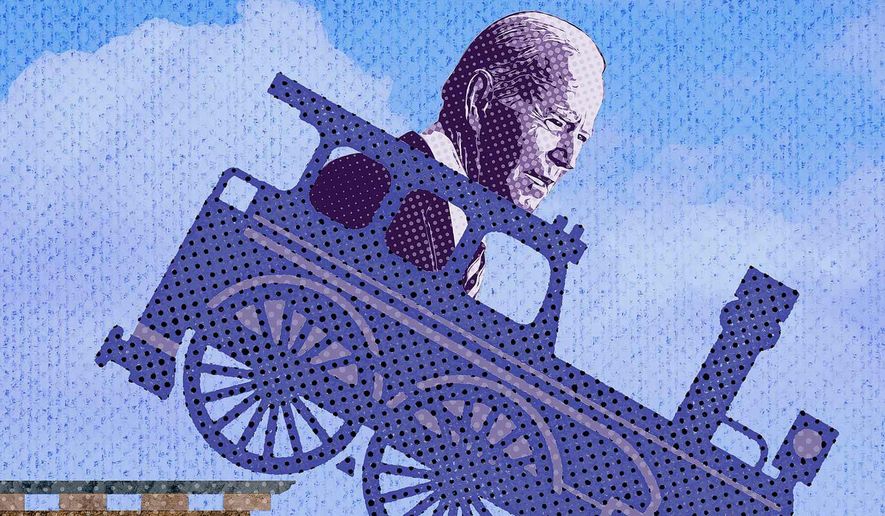OPINION:
There’s a point at which kowtowing to unions gets an administration in trouble, and the Biden administration is creeping right up to the line. With the train derailment in East Palestine, Ohio, still making headlines, the White House is siding with a tiny union against railroad safety.
This has already gotten the administration in trouble with the courts, and has been warned there will be more trouble if it doesn’t change course.
The 5th U.S. Circuit Court of Appeals sent the warning about this overreach recently when it overruled a finding from the Federal Railroad Administration denying a railroad from continuing to improve its safety procedures.
BNSF railroad has been deploying automatic track inspection — or ATI — systems on its tracks in the Western states since 2014. These systems of lasers and cameras, some mounted on locomotives, test the track under the duress of a moving train and can identify defects and flaws in the rails that are invisible to the human eye. These systems collate and analyze data so railroads can identify problems before disaster strikes.
It works. The average human manual inspection of the track turns up 0.1 problems per 100 miles of track. Automatic track inspection systems turn up 4.54 problems per 100 miles. Because they move on trains, they don’t disrupt traffic on the tracks. And because they are automated, workers are safer.
Since 2018, BNSF had been granted numerous waivers by the Federal Railroad Administration from requirements that it engage in human inspection of tracks at given intervals. It still conducted a human inspection, but it received waivers to rely on the ATI systems for its data. The federal agency said it would continue to greenlight waivers as long as the ATI systems delivered on their promise of increased safety.
But when BNSF returned in June 2021 with a waiver request that included an expansion of the use of ATI systems — the railroad wanted to add a Chicago-to-Seattle route and one that connects two towns in Wyoming — the Federal Railroad Administration balked. The agency claimed in a letter to the railroad that it was collecting information to introduce its own program that mixed human inspections with ATI technology, which is what BNSF and others had proposed all along.
The Federal Railroad Administration did not explain why testing could not be expanded while it developed its plan. It even acknowledged that ATI technology was working to make railroads safer and had proved itself on the difficult mountain terrain it would have to traverse for these new routes. But the agency said it could not approve an expansion of waivers because “short-circuiting this evaluation process on individual railroads is not in the public interest and consistent with railroad safety at this time.”
So why promote the progress, say you’re designing a new system around it, then halt testing after you’d promised you would expand it if it was working properly — which you acknowledge it was?
That didn’t make a lot of sense to the 5th Circuit, which declared the decision arbitrary and capricious and ordered it vacated and the matter returned to the agency.
But a closer look at the record surrounding BNSF’s application does reveal a possible reason. The agency opened a public comment period on the proposal and received just one comment — from the Brotherhood of Maintenance of Way Employees Division, a small union affiliated with the Teamsters.
The union, which challenges almost all of BNSF’s waiver requests, said in its comment that it “did not feel” the ATI-based inspection regimen delivered the same level of safety as human inspections — data notwithstanding.
The union does not “feel” ATI won’t work. It fears it will, which could put humans out of work. But humans will always be part of the railroad inspection process. The carriers themselves have acknowledged this.
So this claim didn’t make much sense either, as William C. Vantuono, editor of Railway Age, which covers the industry, explained.
That the agency seems to have acted on precisely one data-free public comment gives “the impression, at least to me, that the denial may be politically motivated,” he wrote. “With all due respect to the men and women who work very hard in the maintenance-of-way discipline, inspecting, building and maintaining roadway — with computerized high-production machines — undermining progress and safety improvements that technology provides is counterproductive and disingenuous.”
The agency has 100 days to act on this matter. Particularly in light of the February derailment in Ohio, it needs to go back to promoting technology and advancing the many ways it can help improve railroad safety.
And the White House needs to take this opportunity to stand up to its union special interests on behalf of railroad safety. Given the focus on rail safety and the administration’s lackluster response, it’s smart policy and smart politics.
• Brian McNicoll, a freelance writer based in Alexandria, Virginia, is a former senior writer for The Heritage Foundation and former director of communications for the House Committee on Oversight and Government Reform.




Please read our comment policy before commenting.